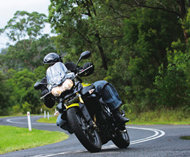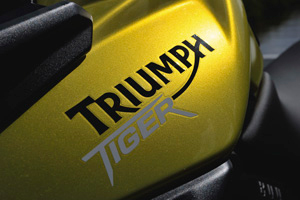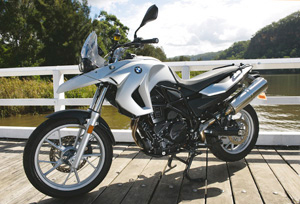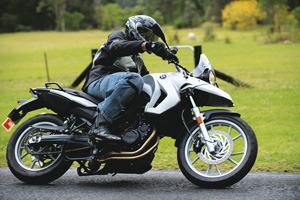
Adopted Aussies 
They’re so good, they’re so right, they’re so … us!
I think we should declare the BMW F 650 GS and Triumph Tiger 800 adopted Aussies. Why? Because these two wonders are so well suited to every road condition our vast country can dish out. Apart from that accolade, at $13,990 for the BMW and $15,290 for the Triumph the prices will tempt lots of riders aboard. And too right, I say.
Two vs three
Although one is a twin and one a triple, their engine characteristics are very similar. The first thing I should point out is that despite its 650 badge, the twin-cylinder BMW F650 GS is actually an 800cc engine — albeit a slightly detuned version of the one in the F 800GS. The Tiger 800 is the triple.
Both engines have the sort of flexibility you’d expect from multi-purpose machines. This means when it comes to riding mundane highways you can save fuel with low revs while enjoying whatever scenery you can see; and for bend swinging you can either use the nice spread of torque to flow through the corners or get up in the rev range and listen to the sweet exhaust notes sing.
Fuel consumption is the only major difference between the two: the GS was sipping 4.28L/100km whereas the Tiger was slurping 5.47L/100km.
Cable-operated clutches on both offer light pull and gear changing was a nice snick of the left foot. The ratios on the Tiger are quite close together, making it great on easy dirt and through twisty roads. The GS box-of-cogs is evenly spread for a more relaxed cruise.

Time to stop
Both bikes work well in the stopping department and have the right amount of feel, so that if you do venture onto dirt roads they won’t lock up the second you squeeze the levers.
The Tiger was adorned with Nissin calipers. The GS, with its Brembos and optional ABS, was the more safety-oriented package. Having said that, the Tiger’s brakes were more responsive; I can’t wait to get my hands on the ABS version to see how that goes.
Suspension and tyres
The suspension setup on each bike can handle most dirt roads if need be. Turn-in is light on each bike but the Tiger is a little more flighty (until you get used to it) — and that’s more to do with the wider bars than the setup. While I’m on that point, one bugbear was the very wide turning circle on the Tiger, which can make life a little more challenging in narrow places.
Pirelli Scorpion tyres are standard on the Tiger and lose a bit of feel in the front, but if it had the same Metzeler Tourance tyres fitted to the BMW I’d have to say it would be the complete package.
Are we comfortable?
The Tiger comes way out in front in the comfort stakes. The seat is just wonderful whereas the GS’s is a little firm even after just a short while. The extra bar width on the Tiger (although I said it makes the bike flighty) makes riding long distances easy and when it comes to a dirt road you can stand up for total control.
The GS will suit shorter riders because it is smaller and 11 kilos lighter and there’s a low seat option (790mm) for the really vertically challenged. The Tiger looks after all rider heights with an adjustable seat. Of course, I preferred the higher seat but for our test adjusted the Tiger to its lower setting, which is similar to the GS, and still found both bikes had good seat-to-peg relationship. Adjust the bars and there’s a wide spread of options for just about everyone.

Screens
The screen on the GS actually worked quite well, considering its size. The Tiger has a taller screen that is great for sitting down and also deflects wind and debris while standing up on a dirt road. Small but effective wind deflectors on the side of each bike give your legs a little protection from the elements, which would be particularly handy in the colder months.
Controls
BMW still has the quirky three-button indicator setup which can be a pain to use; it would be so much better with one conventional button, leaving your right hand to twist the throttle.
Dash layouts are similar and offer all the information the all-round rider wants. The GS has tyre pressure monitors fitted and these are offered as options on the Tiger. Both have gear position indicators and range-to-empty fuel indicators.
Let’s accessorise
What’s the one thing you might want on these machines? Luggage! Triumph has both hard and soft luggage options and having seen an XC version loaded up I see long trips in your future if you kit the Tiger out.
The GS offers hard plastic “Variable” panniers and a “Variable” topbox that are rugged enough to handle most situations.
Triumph has 42 accessories for the Tiger 800, which is fantastic. BMW doesn’t have that many which may steer some riders who want the total package towards the Tiger.
Both machines come standard with cast alloy wheels; if you did want to get a little more serious on dirt, wire-spoked wheels could be fitted. (Remember though that Triumph offers the more serious XC version of the Tiger and it could work out better to buy that instead.) Likewise, BMW offers the F 800 GS but its seat is taller and it is heavier.

These two all-rounders will more than satisfy you and they are both rugged enough to handle our harsh terrain while you enjoy what motorcycling is all about: sovereignty. SW
Quickspecs
Model: BMW F 650 GS
Price: $13,990 (plus on-road charges)
Warranty: Two years, unlimited distance
Servicing km intervals: 1000km; every 10,000km thereafter
Engine: Liquid-cooled, 4 valve per cylinder DOHC, twin cylinder, 4-stroke
Bore × stroke: 82×75.6mm
Displacement: 798cc
Compression: 12.0:1
Power: 52kW @ 7000rpm
Torque: 75Nm @ 4500rpm
Transmission: Six-speed, wet multi-plate clutch, chain final drive
Suspension: Front, 41mm telescopic fork, non-adjustable, travel 180mm. Rear, monoshock, adjustable preload and rebound, 170mm travel
Dimensions: Seat height 820mm, kerb weight 199kg, wheelbase 1575mm
Tyres: Front, 110/80/R19. Rear, 140/80/R17
Frame: Tubular steel space frame, load-bearing engine
Brakes: Front, single 300mm disc with dual-piston caliper (optional ABS). Rear, 265mm disc, single-piston caliper (optional ABS)
Fuel capacity: 16 litres
Fuel consumption: 4.28L/100km, premium unleaded
Theoretical range: 370km
Colours: 30th GS Edition; Biarritz Blue Metallic; Lava Orange Metallic; White Aluminium Matt Metallic
Verdict: Aussie, Aussie, Aussie …
Quickspecs
Model: Triumph Tiger 800
Price: $14,390 (plus on-road charges)
Warranty: Two years, unlimited distance
Servicing km intervals: 1000km; 6000km; every 6000km thereafter
Engine: Liquid-cooled, 4 valve per cylinder DOHC, in-line three cylinder, 4-stroke
Bore × stroke: 74×61.9mm
Displacement: 799cc
Compression: 12.0:1
Power: 70kW @ 9300rpm
Torque: 79Nm @ 7850rpm
Transmission: Six-speed, wet multi-plate clutch, chain final drive
Suspension: Front, 43mm inverted fork, non-adjustable, travel 180mm. Rear, monoshock, adjustable preload and rebound, 170mm travel
Dimensions: Seat height 810-830mm, kerb weight 210kg, wheelbase 1,555mm
Tyres: Front, 110/80/ZR19. Rear, 150/70/ZR17
Frame: Tubular steel trellis frame
Brakes: Front, twin 308mm discs with four-piston monobloc calipers (optional ABS). Rear, 255mm disc, twin-piston caliper (optional ABS)
Fuel capacity: 19 litres
Fuel consumption: 5.47L/100km, premium unleaded
Theoretical range: 345km
Colours: Phantom Black; Crystal White; Venom Yellow
Verdict: Oi, Oi, Oi!!!!
PULL OUT
For bend swinging you can either use the nice spread of torque to flow through the corners, or get up in the rev range and listen to the sweet exhaust notes sing.
